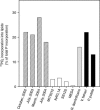Sulfolipids dramatically decrease phosphorus demand by picocyanobacteria in oligotrophic marine environments
- PMID: 16731626
- PMCID: PMC1482627
- DOI: 10.1073/pnas.0600540103
Sulfolipids dramatically decrease phosphorus demand by picocyanobacteria in oligotrophic marine environments
Abstract
There is growing evidence that dissolved phosphorus can regulate planktonic production in the oceans' subtropical gyres, yet there is little quantitative information about the biochemical fate of phosphorus in planktonic communities. We observed in the North Pacific Subtropical Gyre (NPSG) that the synthesis of membrane lipids accounted for 18-28% of the phosphate (PO4(3-)) taken up by the total planktonic community. Paradoxically, Prochlorococcus, the cyanobacterium that dominates NPSG phytoplankton, primarily synthesizes sulfoquinovosyldiacylglycerol (SQDG), a lipid that contains sulfur and sugar instead of phosphate. In axenic cultures of Prochlorococcus, it was observed that <1% of the total PO4(3-) uptake was incorporated into membrane lipids. Liquid chromatography/mass spectrometry of planktonic lipids in the NPSG confirmed that SQDG was the dominant membrane lipid. Furthermore, the analyses of SQDG synthesis genes from the Sargasso Sea environmental genome showed that the use of sulfolipids in subtropical gyres was confined primarily to picocyanobacteria; no sequences related to known heterotrophic bacterial SQDG lineages were found. This biochemical adaptation by Prochlorococcus must be a significant benefit to these organisms, which compete against phospholipid-rich heterotrophic bacteria for PO4(3-). Thus, evolution of this "sulfur-for-phosphorus" strategy set the stage for the success of picocyanobacteria in oligotrophic environments and may have been a major event in Earth's early history when the relative availability of sulfate and PO4(3-) were significantly different from today's ocean.
Conflict of interest statement
Conflict of interest statement: No conflicts declared.
Figures



References
-
- Karl D., Letelier R., Tupas L., Dore J., Christian J., Hebel D. Nature. 1997;388:533–538.
-
- Karl D. M. Ecosystems. 1999;2:181–214.
-
- Emerson S., Quay P., Karl D., Winn C., Tupas L., Landry M. Nature. 1997;389:951–954.
-
- Wu J., Sunda W., Boyle E. A., Karl D. M. Science. 2000;289:759–762. - PubMed
-
- Bjerrum C. J., Canfield D. E. Nature. 2002;417:159–162. - PubMed
Publication types
MeSH terms
Substances
LinkOut - more resources
Full Text Sources
Other Literature Sources

